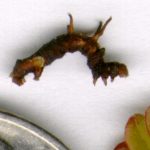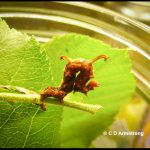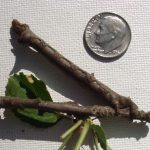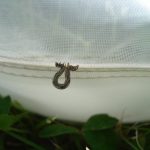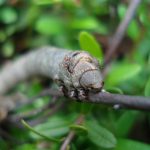Spanworms
Order: Lepidoptera || Family: Geométridae (spanworms, measuringworms, geometers or inchworms — all synonymous terms); A very large family with roughly 1400 species in the US and Canada.
- Horned Spanworm (also called Filament Bearer), Nematocampa resistaria
- Horned Spanworm (Filament Bearer) (Washington County, Maine; 6/24/2004)
- Horned Spanworm Moth (Nematocampa resistaria) (shown with the empty pupa from which it emerged) (Washington County, Maine; 9/29/2008)
- Brown spanworm larvae beside a cranberry upright upon which they were previously feeding.
- A Green Spanworm
- Closer view of a Green Spanworm
- A pair of Green Spanworms – photographed in early July of 2009
- A Chainspotted Geometer (also called Chain-dotted Geometer, Cingilia catenaria (photographed mid-July in Maine)
- a Chainspotted Geometer larva, feeding on a cranberry upright, and photographed in July (in Maine)
- Another example of a Chainspotted/Chain-dotted Geometer
- Another photo of a Chainspotted Geometer, ‘looping,’; photographed in July (in Maine)
- A Chainspotted Geometer Moth (photographed in mid-September, in Maine)
- A species of spanworm (possibly Big Cranberry Spanworm)
- Possibly a ‘Big Cranberry Spanworm’ or similar species (they are masters of camouflage; the portion angled up and closest to the dime is the spanworm) (Photographed 7/10/2003)
- A spanworm larva (no identification as yet), showing the classic ‘looping’ pattern of locomotion; photographed mid-June in Maine
- Another example of a spanworm larva (no identification as yet)
- Cranberry Spanworm Moth (Ematurga amitaria) (7/8/2007) (Washington County, Maine)
- Black-banded Orange Moth (Macaria truncataria) (5/27/2000) (Washington County, Maine)
Spanworms (Family Geométridae), many of which will feed on cranberry, make up the second largest family of Lepidoptera in eastern forests. Many of them find themselves in cranberry beds by accident, having been blown in by the wind or through some other incidental means. As a rule, they are masters of camouflage—mimicking foliage, sticks, petioles, and other plant parts. With rare exception, all can be readily recognized by the possession of only a single pair of mid-abdominal prolegs. Being so endowed, they tend to loop rather than crawl, hence the term, ‘looper’. During three of the last 14 years (1999, 2001 & 2002), high spanworm populations were observed on Maine cranberry beds. The most notable years were 2001 and 2002, with 33% of monitored sites in 2001 surpassing the Action Threshold (AT) of 4.5 larvae per 25 sweeps, and 19% of sites surpassing the AT in 2002. A key factor appears to be weather. Each of the three high-spanworm summers were very hot and dry, just the way spanworms and many other non-aquatic insects like it. The summers of 1999, 2001 and 2002 had 17% below normal rainfall, 22% below normal rainfall, and 20% below normal rainfall, respectively. 2001 saw Maine’s 13th driest summer on record since 1895, and 1999 and 2002 tied for a ranking of 15, where 1 = the driest and 108 = the wettest. Many spanworm caterpillars first appear in early-season sweeps (late May to early June*). Newly-hatched spanworms cling to the inside of the sweepnet. Be aware of spanworm infestations during bloom also. They may be quite clumped in patches throughout the bed.
*Note: If Winter Moth spanworm caterpillars ever show up on any of our Maine cranberry beds, they would be present and feeding much earlier–in late April/early May just as the vines are greening up–compared to our other spanworms which show up about a month later than that. For more information, see also: Winter Moth (Maine Forest Service), and the Bangor Daily reported on this pest on June 5th, 2012 after it was discovered in the Town of Harpswell: Bangor Daily 2012 Winter Moth Story.
Green Spanworm — Itame sulphurea (Packard): This spanworm hasn’t been found in very high numbers on Maine cranberry beds, but is capable of doing considerable harm. The traditional Action Threshold (AT), however, is different from all of our other spanworms (18 per 25 sweeps rather than 4.5 per 25 sweeps). Where it is often found in combination with other spanworms, though, I believe using an AT of 4.5 (or 9 depending on berry price) per 25 sweeps makes scoring them, and thus management decisions, a little simpler to remember. In 1920 and 1921, it devastated the entire crop on a very large scale for many Massachusetts growers. [See also pages 27-28 of Cranberry Insects of the Northeast by A.L. Averill & M.M. Sylvia (1998)]
 Chainspotted Geometer (Chain-dotted Geometer) — Cingilia catenaria (Drury): This spanworm, also referred to as the Chain-dotted Geometer, is usually found in low numbers on Maine cranberry beds but it is regarded as a “boom and bust” species overall in nature. In addition to cranberry, the larvae also feed on a wide variety of trees and shrubs including: alder, bayberry, birch, blueberry, bog laurel, gale, huckleberry, larch, leatherleaf, maple, northern white cedar, oak, pine, poplar, sweet fern and willow. It is often conspicuously abundant in peatlands. Severe local outbreaks occurred on cranberry in Cape Cod in 1927 and 1934, but in more recent times its numbers in Massachusetts have declined such that it even appeared on the Massachusetts endangered species list at one time.
Chainspotted Geometer (Chain-dotted Geometer) — Cingilia catenaria (Drury): This spanworm, also referred to as the Chain-dotted Geometer, is usually found in low numbers on Maine cranberry beds but it is regarded as a “boom and bust” species overall in nature. In addition to cranberry, the larvae also feed on a wide variety of trees and shrubs including: alder, bayberry, birch, blueberry, bog laurel, gale, huckleberry, larch, leatherleaf, maple, northern white cedar, oak, pine, poplar, sweet fern and willow. It is often conspicuously abundant in peatlands. Severe local outbreaks occurred on cranberry in Cape Cod in 1927 and 1934, but in more recent times its numbers in Massachusetts have declined such that it even appeared on the Massachusetts endangered species list at one time.
Caterpillar Description: Yellow to straw-colored with round black spots on various parts of their bodies. There is a row of conspicuous white spots along each side of the body, mostly above the spiracles. Most of these spots are bordered with one black spot in front and another behind. When full grown, they are about 1.5 to 2 inches long, and as they mature they have the habit of hanging straight downward, motionless, during the day. They feed mainly in the early evening and into the night. The pupal stage lasts about a month and the moths appear in September and very early October at which point they mate and lay eggs which overwinter [See also pages 32-33 of Cranberry Insects of the Northeast by A.L. Averill & M.M. Sylvia (1998)].
Spiny Looper – Phigalia titea (Cramer): No photo available; The populations of this spanworm apparently cycle in forest stands, similar to other forest caterpillar pests, where it is typical to have several years of very low populations, followed by one or two years of extremely high populations that subsequently crash due to external factors such as viruses, fungi, lack of food, predators and parasitoids, etc. It was reported on one Maine cranberry site in 2006, where numbers were described as quite high in distinct portions (patches) of the bed—highly characteristic of this spanworm—and left the infested area looking brown and burned. The larvae feed on the leaves of new growth. Some larvae nip the stem of new shoots, which then fall over. Its seasonal history has not been studied on cranberry. Over the last several years, though, it has become a significant problem for many Massachusetts growers so we may be learning more about this spanworm in the future. [See also pages 31-32 of Cranberry Insects of the Northeast by A.L. Averill & M.M. Sylvia (1998)]

Big cranberry spanworm — Eutrapela clemataria (J.E. Smith): Though only a few of these have been seen on Maine beds per season, they can be extremely destructive in small patches of a bed, resulting in fairly circular areas of damaged vines. They prefer to sever the flower buds and blossoms. Larvae appear in late June in Maine. They are dark brown with bumps across their back, are masters of camouflage (look just like a twig), and grow to 2.5″ in size. Spot-treating is usually the best approach if any site in Maine should ever discover a problem with this particular spanworm.
- Possibly a Big Cranberry Spanworm (July 24, 2014) (it highly resembles a twig and is definitely ‘big’)
- Possibly a Big Cranberry Spanworm (July 24, 2014)
- Possibly a ‘Big Cranberry Spanworm’ or similar species (they are masters of camouflage; the portion angled up and closest to the dime is the spanworm) (Photographed 7/10/2003)
- A twig found on a cranberry bed that looks very much like a big cranberry spanworm larva. Whereas twigs like this are likely common in a bed of cranberries, it makes sense why a spanworm might benefit from resembling one.
 Black-banded Orange (Macaria truncataria): No caterpillar picture available; This spanworm, in the adult stage shown here, is a rather rare, day-flying (diurnal) moth. It is present in the adult stage from May to July and its preferred larval host plant is Bearberry (Arctostaphylos uva-ursi), but it can probably survive on cranberry as well. The moth is found in peat or sphagnum bogs (such as cranberry bogs). The eggs are laid singly on the underside of leaves of the bearberry plant. (Perhaps they are also laid on cranberry leaves, but that is impossible to say at this point), but from some general information on this spanworm that was found in the Guide to the Geometridae of Canada (Lepidoptera), it is reportedly found in Newfoundland and Labrador, and north to Alaska and south to New Jersey in the east and Colorado and Arizona in the west. Some other regions mentioned in Canada where it is found include Nova Scotia, southern Ontario, southern Manitoba, Laurentide Park in Quebec, and in the mountainous areas of southern Alberta and British Columbia.
Black-banded Orange (Macaria truncataria): No caterpillar picture available; This spanworm, in the adult stage shown here, is a rather rare, day-flying (diurnal) moth. It is present in the adult stage from May to July and its preferred larval host plant is Bearberry (Arctostaphylos uva-ursi), but it can probably survive on cranberry as well. The moth is found in peat or sphagnum bogs (such as cranberry bogs). The eggs are laid singly on the underside of leaves of the bearberry plant. (Perhaps they are also laid on cranberry leaves, but that is impossible to say at this point), but from some general information on this spanworm that was found in the Guide to the Geometridae of Canada (Lepidoptera), it is reportedly found in Newfoundland and Labrador, and north to Alaska and south to New Jersey in the east and Colorado and Arizona in the west. Some other regions mentioned in Canada where it is found include Nova Scotia, southern Ontario, southern Manitoba, Laurentide Park in Quebec, and in the mountainous areas of southern Alberta and British Columbia.
- Black-banded Orange Moth (Macaria truncataria) (5/27/2000) (Washington County, Maine)
- Black-banded Orange Moth (Macaria truncataria) (5/27/2000) (Washington County, Maine)
Control: For specific and current control recommendations for Maine, please refer to the Maine Cranberry Pest Management Guide. Look for the ‘Spanworms’ section in the Insects portion of the guide.

